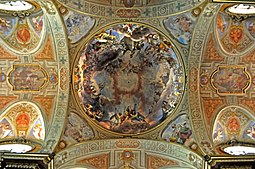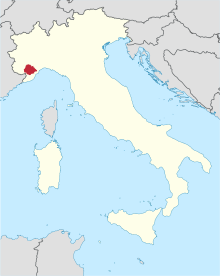History
The town, then called Monsvici or Monteregale, was a part of the diocese of Asti until 1198, when it established itself as a commune. [4] The commune had a podestà. [5]
The diocese of Mondovi was established during the Great Schism by Pope Urban VI of the Roman Obedience, in the papal Bull, Salvator Noster of 8 June 1388. [6] On 26 June 1388, he established Mondovi as a civitas. [7] The city of Mondovì provided the bishop with an episcopal palace, next to the church of S. Antonio. [8]
The first bishop of Mondovì was the Dominican Damiano Zavaglia; among his successors were Percivallo di Palma (1429), Amadeo Romagnano (1497), who reconstructed the cathedral (1550); Michele Ghislieri, O.P. (1550), Grand Inquisitor [9] and later Pope Pius V; Cardinal Vincenzo Lauro (1566), founder of the seminary, during whose incumbency the cathedral and other churches were torn down to make room for the citadel; Giovanni Battista Isnardi (1697), who restored the episcopal palace and the church of St. Dalmazaio; Carlo Felice Sanmartino (1741), founder of the new seminary, and Giovanni Tommaso Ghilardi, O.P. (1842).
The city, at first part of the Diocese of Asti, became the seat of a bishop, suffragan of the Archbishop of Milan, but, since 1515, the Archdiocese of Turin has been its metropolitan. [10] In 1817, the territory of Cuneo was detached from the See of Mondovì, making the diocese of Cuneo.
Cathedral and Chapter
The Cathedral of Mondovi is dedicated to S. Donato. [11] In the bull in which he created the diocese, Pope Urban VI says that he promotes the Collegiate Church of S. Donato into a cathedral church. [12] The cathedral was served by a Chapter, which, as Pope Urban says, is to have the same dignities with the same names as that of Asti, and ten canons with the same titles as those of the Chapter of Asti. The Chapter of Mondovì was made up of four dignities (the Archdeacon, the Archpriest, the Provost, and the Cantor) and eight Canons. There were also sixteen Chaplains. [13] The Pope, unfortunately, makes no mention of how the dignities and Canons are to be appointed or by whom. It is known that the first two bishops installed no Canons. [14] Statutes of the Cathedral Chapter of Mondovì were approved by the Chapter on 23 September 1480, and ratified by the Archdeacon of Turin, Guillermo Caccia, JUD and Protonotary Apostolic, the Apostolic Delegate. [15]
In 1577, Duke Emmanuel Philibert, faced with the need to fortify the city of Mondovì, announced that he needed the hilltop on which the Cathedral church of S. Donato had existed for many centuries. His plans also required the demolition of the churches of San Domenico (which belonged to the Dominican friars) and Sant'Antonio (which belonged to the Jesuits. After consultations with the Papal Nuncio in Turin, Gerolamo de'Federici, and all the parties concerned in Mondovì (the Bishop, Vincenzo Lauro, the Cathedral Chapter, and all of the religious orders), the plan was submitted to Pope Gregory XIII to transfer the seat of the bishop from S. Donato to the Franciscan church of San Francesco, and to move the Franciscans to Sant'Andrea. The Dominicans would be assigned the parish church of Carassone which had the title of San Giovanni di Lupazano. The Jesuits would be moved to the palazzo of Francesco da Ponte. On 15 March 1577 the Pope gave his consent, and the church of San Francesco became the Cathedral of Mondovì, under the title of S. Donato. The Franciscans were authorized to build a new church of San Francesco. [16] Bishop Lauro succeeded Bishop Gerolamo de'Federici as Papal Nuncio in Turin, and was made a cardinal by Gregory XIII in 1583. [17]
In 1835, the Chapter was made up of six dignities and fourteen Canons. The dignities were: Archdeacon, Archpriest, Provost, Cantor, Penitentiary and Theologus. [18] The Canon Penitentiarius and the Canon Theologus were added by Bishop Vincenzo Lauro in 1580 and 1584. [19]
The cathedral contains paintings by Giulio Romano, Cambiaso, and others. The residence of the bishop is one of the most impressive episcopal palaces in Italy. In the church of la Missione there are frescoes by the Jesuit Andrea Pozzo. [20]
Outside the city is the sanctuary of the Madonna del Pilone, dating from the fourteenth century, but finished later (1730–49). The palace of the counts of San Quintino contained the first printing-office in Piedmont, and was the seat of a university (1560–1719) founded by Duke Emmanuel Philibert, the first institution of its kind in Piedmont. [21]
Diocesan synods
A diocesan synod was an irregularly held, but important, meeting of the bishop of a diocese and his clergy. Its purpose was (1) to proclaim generally the various decrees already issued by the bishop; (2) to discuss and ratify measures on which the bishop chose to consult with his clergy; (3) to publish statutes and decrees of the diocesan synod, of the provincial synod, and of the Holy See. [22]
Bishop Gerolamo Calagrano (1490–1497) held a diocesan synod in 1495, the statutes of which were published. [23] In 1573 Bishop Vincenzo Lauro presided at a diocesan synod. [24] On 15 September 1592 Bishop Giovanni Antonio Castruccio (1590–1602) held his second diocesan synod, and had the Statutes published. [25] Bishop Michele Casale held a diocesan synod in Mondovi on 1—3 September 1763. [26] Bishop Placido Pozzi held a diocesan synod on 16—18 September 1879. [27]
The diocesan Seminary was built by Bishop Vincenzo Lauro in 1573, [28] and rebuilt by Bishop Carlo Felice Sammartino in 1742. [29]

The Diocese of Nola is a Latin diocese of the Catholic Church in Italy, suffragan of the Archdiocese of Naples. Its seat is the Campanian city of Nola, now a suburb of Naples. Its cathedral is dedicated to the Assumption. The dedication was originally to S. Stephen, the Protomartyr, but after the second reconstruction the dedication was changed to the Assumption. It is traditionally credited with the introduction of the use of bells into Christian worship.

The Diocese of Alba Pompeia or Alba Pompea is a Latin Church ecclesiastical territory or diocese of the Catholic Church in Italy. Its territory comprises eighty towns in the civil Province of Cuneo and two in the Province of Asti.

The Diocese of Saluzzo is a Latin diocese of the Catholic Church in the Piedmont region of northwestern Italy, centered in the comune of Saluzzo. The diocese was established on 29 October 1511 for political reasons, to transform the Marquisate of Saluzzo into an ecclesiastic territory, and was directly dependent upon the Holy See. It is now a suffragan of the Archdiocese of Turin.

The Diocese of Rieti is a Latin Church ecclesiastical territory or diocese of the Catholic Church in Italy. It is immediately exempt to the Holy See. Its cathedra is in St. Mary Cathedral in the episcopal see of Rieti.
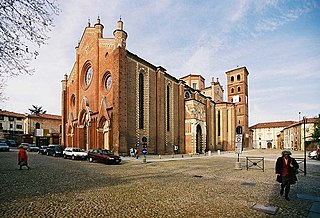
The Diocese of Asti is a Latin diocese of the Catholic Church in Piedmont, northern Italy, centered in the city of Asti. It has been a suffragan of the Archdiocese of Turin since 1515. Previous to that, it was a suffragan of the Archdiocese of Milan.

The Diocese of Nocera Umbra was a Catholic diocese in Umbria, Italy.
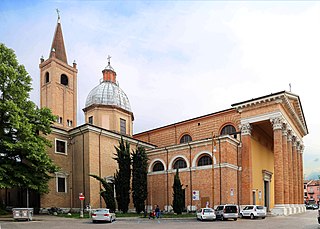
The Diocese of Forlì-Bertinoro is a Latin diocese of the Catholic Church in Romagna, Italy. Until 1986 it was known as the Diocese of Forlì, in existence perhaps from the fourth century. In that year the Diocese of Bertinoro was united to it. The diocese is suffragan to the Archdiocese of Ravenna-Cervia.

The Diocese of Viterbo is a Latin Church ecclesiastical territory or diocese of the Catholic Church in central Italy. From the 12th century, the official name of the diocese was the Diocese of Viterbo e Tuscania. In 1986, several dioceses were combined, and the title was changed to "Diocese of Viterbo, Acquapendente, Bagnoregio, Montefiascone, Tuscania and San Martino al Monte Cimino"; in 1991 the name was shortened to "Diocese of Viterbo".

The diocese of Montefiascone was a Catholic ecclesiastical territory in Italy. It was created from the diocese of Bagnorea in 1369. In 1986 was incorporated into the diocese of Viterbo, Acquapendente, Bagnoregio, Montefiascone, Tuscania e San Martino al Monte Cimino. The diocese was immediately subject to the Holy See.
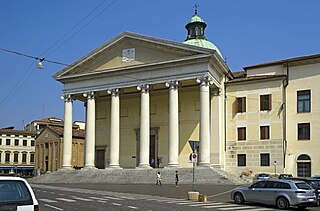
The Diocese of Treviso is Latin Church ecclesiastical territory or diocese of the Catholic Church in the Veneto, Italy. It is a suffragan diocese in the ecclesiastical province of the metropolitan Patriarchate of Venice.
The Catholic diocese of Sarsina was a Roman Catholic ecclesiastical territory in Emilia-Romagna, northern Italy, seated in Sarsina, in the province of Forlì, some 32 km south-southwest of Cesena. The diocese was founded in the 5th century, and was suffragan (subordinate) to the archbishop of Ravenna. The diocese existed until 1986, when it was united with the diocese of Cesena.

The Diocese of San Severo is a Latin diocese of the Catholic Church in Apulia. It is a suffragan of the Archdiocese of Foggia-Bovino.

The Diocese of Chioggia is a Latin diocese of the Catholic Church in the Veneto, at the southernmost point of the Laguna veneta. Until 1451, the diocese was a suffragan of the Patriarchate of Grado. On 8 October 1451, in the bull "Regis Aeterni", Pope Nicholas V abolished the patriarchate of Grado, and transferred its powers and privileges to the Archdiocese of Venice. Since then, Chioggia has been a suffragan of Venice.
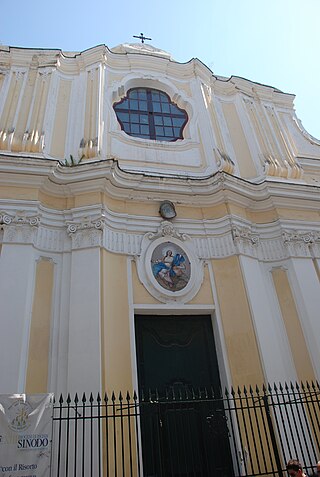
The Diocese of Ischia is a Latin diocese of the Catholic Church in Campania, southern Italy. It is a suffragan of the Archdiocese of Naples. The diocese comprises the entire island of Ischia, which contains seven communes divided into two circumscriptions. In 1743, the population was about 4,000. The city of Ischia constituted one single parish, with two religious houses of men and one of women. In 2018, the population of the town of Ischia was 20,118.

The Diocese of Fossano is a Latin diocese of the Catholic Church in Piedmont, in the Province of Cuneo. It is a suffragan of the Archdiocese of Turin.
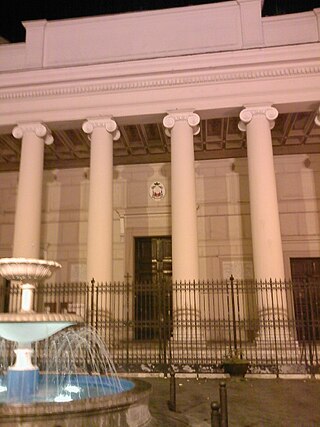
The Diocese of Acerra is a Latin diocese of the Catholic Church in Campania, southern Italy, eight miles east of Naples, in the area once called Terra Laboris (Liburia). It has existed since the 11th century. It is a suffragan of the Archdiocese of Naples.

The Diocese of Sessa Aurunca is a Latin diocese of the Catholic Church in southern Italy. Since 1979 it has been a suffragan of the Archdiocese of Naples.

The Diocese of Anagni-Alatri is a Latin Church ecclesiastical territory or diocese of the Catholic Church in Lazio, Italy. It has existed in its current form since 1986. In that year the Diocese of Alatri was united to the historical Diocese of Anagni. The diocese is immediately exempt to the Holy See.
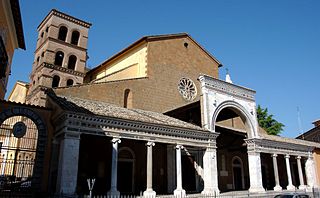
The Diocese of Civita Castellana is a Latin Church ecclesiastical territory or diocese of the Catholic Church in Latium, central Italy. It has existed in the current form since 1986, when the Diocese of Nepi e Sutri was united into the Diocese of Civita Castellana, Orte e Gallese. The Diocese of Gallese had been added to the Dioceses of Civita Castellana and Orte in 1805. The name of the diocese was shortened in 1991, in accordance with Vatican policies. The diocese of Civita Castellana is immediately exempt to the Holy See.
The Diocese of Satriano e Campagna was a Roman Catholic diocese located in the town of Satriano in the Province of Catanzaro in the Calabria region of southern Italy. In 1818, the diocese of Campagna was united with the Archdiocese of Conza to form the Archdiocese of Conza e Campagna. The diocese of Satriano was completely suppressed, and its territory incorporated into the diocese of Campagna.
